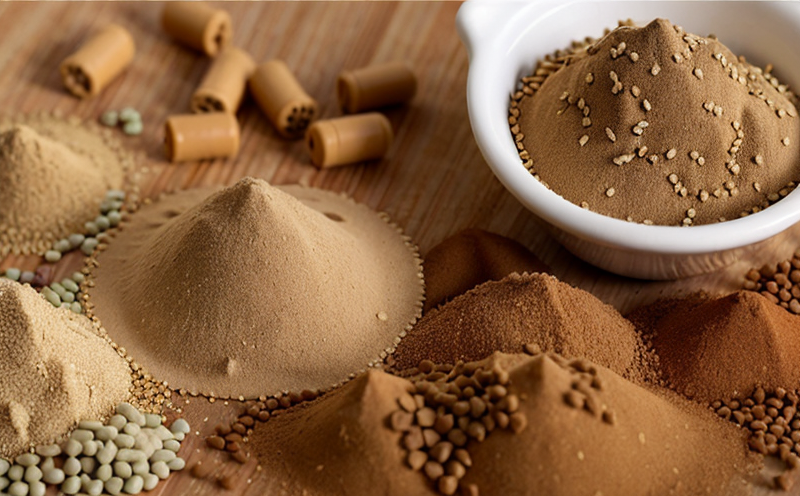Salinomycin Residue Testing in Animal Feed
Salinomycin, a polyether ionophore antibiotic, is widely used in veterinary medicine to improve feed efficiency and weight gain in livestock. Its use extends beyond its direct medicinal applications as it can be found in animal feed through residues from medicated feeds. Ensuring the safe and accurate detection of salinomycin residues is paramount for maintaining public health standards and regulatory compliance.
The presence of salinomycin residues in animal products, particularly meat, milk, and eggs, has been linked to various health risks, including gastrointestinal disorders and antibiotic resistance. Consequently, strict regulations have been implemented globally to monitor the levels of this drug in feed and foodstuffs. This service focuses on providing precise quantitative analysis for salinomycin residues in animal feeds using advanced laboratory techniques.
To ensure accurate results, our team employs a combination of sample preparation methods tailored to the matrix of interest—animal feed—and state-of-the-art analytical instrumentation. The process begins with careful sampling and homogenization followed by extraction procedures designed to isolate salinomycin from other components effectively. Chromatographic techniques such as Liquid Chromatography Tandem Mass Spectrometry (LC-MS/MS) are utilized for reliable quantification.
Our laboratory adheres strictly to international standards like ISO 17025 and EU directives regarding veterinary drug residues in foodstuffs, ensuring our methodologies meet the highest industry benchmarks. By leveraging these stringent protocols and cutting-edge technology, we deliver accurate measurements that contribute to safer agricultural practices and consumer confidence.
Understanding the implications of salinomycin residue levels is crucial for stakeholders across various sectors including agriculture, veterinary science, and public health. Regular testing helps prevent potential risks associated with excessive consumption of medicated feeds leading to improved food safety standards.
| Sample Type | Standard Methodology |
|---|---|
| Dry feed ingredients (e.g., corn, soybean meal) | Extraction with aqueous methanol; LC-MS/MS detection |
| Processed feeds for ruminants and monogastrics | Solvent-based extraction followed by cleanup step; LC-MS/MS quantification |
The complexity of sample matrices often requires extensive background knowledge to achieve precise results. Our team comprises experts who understand these nuances, ensuring that every test conducted aligns with scientific rigor and regulatory requirements.
Industry Applications
Salinomycin residue testing plays a critical role in several key areas within the agriculture and forestry sectors:
- Agricultural Feed Manufacturers: Ensures compliance with regulatory limits on salinomycin levels, thereby protecting consumer health.
- Veterinary Practitioners: Assists in determining appropriate dosages for therapeutic applications without causing adverse effects due to over-administration.
- Regulatory Bodies: Provides data necessary for enforcing bans or restrictions on the use of salinomycin when harmful residues are detected above permissible limits.
- Farmers and Ranchers: Helps in making informed decisions about feed usage, reducing risks associated with improper application practices.
| Sample Type | Methodology |
|---|---|
| Ruminant Feed Samples | Extraction using acetonitrile; clean-up using solid phase extraction (SPE) |
| Poultry Feed Samples | Acidification followed by extraction with ethyl acetate; LC-MS/MS quantification |
Understanding how different sample types behave during analysis helps tailor our approach to deliver consistent and reliable results across diverse feeds.
Eurolab Advantages
- Accurate Results: Leveraging advanced analytical tools ensures precise measurements even at trace levels of salinomycin residues.
- Regulatory Compliance: Our methods align with international standards such as ISO 17025, guaranteeing adherence to stringent quality assurance practices.
- Expertise: Drawn from experienced professionals with deep knowledge in veterinary science and agriculture, providing unparalleled expertise.
- State-of-the-Art Facilities: Equipped with the latest instrumentation, allowing for efficient processing of large volumes of samples while maintaining accuracy.
- Rapid Turnaround Times: Efficient workflows enable quick turnaround times without compromising on quality.
- Comprehensive Reporting: Detailed reports provide insights beyond just numbers, helping stakeholders make informed decisions confidently.
At Eurolab, we pride ourselves on delivering exceptional service backed by years of experience and cutting-edge technology. Whether you are a small-scale farmer or an international corporation, our commitment to excellence ensures your peace of mind regarding the safety and quality of your products.
International Acceptance and Recognition
The importance of accurate salinomycin residue testing cannot be overstated. Regulatory bodies around the world recognize the significance of this service, endorsing it as a fundamental aspect of maintaining food safety standards:
- European Union (EU): The EU has set specific limits for salinomycin residues in animal feed, and compliance is monitored rigorously.
- American FDA: The U.S. Food and Drug Administration enforces strict guidelines on veterinary drug residues, including those of salinomycin.
- World Health Organization (WHO): WHO guidelines emphasize the need for reliable residue testing to protect public health.
- International Organization for Standardization (ISO): ISO 17025 accreditation underscores our commitment to quality and reliability in all laboratory procedures.
The global consensus on this issue reflects the shared goal of ensuring safe food products. By adhering to these standards, Eurolab ensures that its clients receive results they can trust, contributing significantly to international efforts towards safer agricultural practices.





